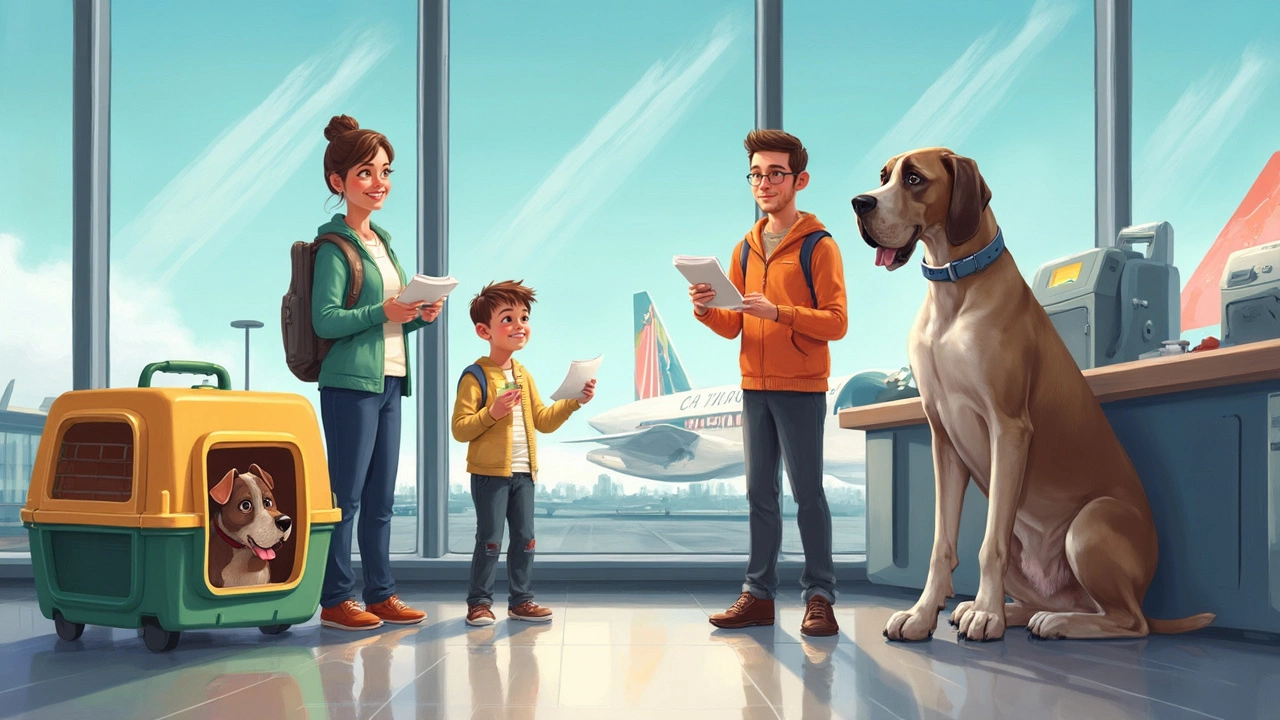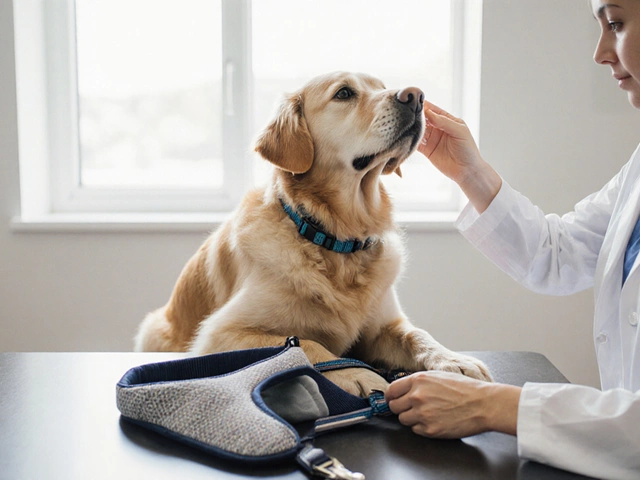Have you ever wondered whether your pet is better off flying in the cabin with you or down in cargo? It’s not just a cat vs dog thing; it’s more about their size, temperament, and even the specific airline’s policies. But fear not! I'm here to help you figure it out.
First off, size matters. Smaller pets usually qualify for in-cabin travel as long as they fit comfortably in a carrier under the seat. The plus side? You get to keep an eye on them, making the experience less stressful for both you and your pet. However, there are limitations, like weight and dimensions, which vary by airline.
Now, not every pet is a good fit for cabin life during a flight. Larger breeds like German Shepherds or Great Danes don't exactly fit under a seat! These big fellas are often better suited for cargo travel, where they can have a bit more room to turn around and lie down. Though it sounds daunting, modern cargo holds are climate-controlled and safe for pets when managed properly.
- The Basics of In-Cabin and Cargo Pet Travel
- Pros and Cons: Keeping Your Pet in the Cabin
- When Cargo is the Better Option
- Airline Policies and What You Need to Know
- Tips for a Smooth Trip with Your Pet
The Basics of In-Cabin and Cargo Pet Travel
So, you're planning to take your furry friend on a flight, and you're stuck deciding between pet travel options: in-cabin or cargo. Let's break down what each option entails, so you can choose what suits you and your pet best.
When it comes to in-cabin travel, your pet will be right there with you in the passenger compartment. This is generally restricted to small pets, like cats and small dogs, since they need to fit in a carrier that's small enough to slide under the seat in front of you. Airlines have specific dimensions for these carriers, often around 17 inches long, 10 inches high, and 9 inches wide, but it's best to double-check with your airline just to be sure.
For larger pets, cargo travel is often the only option. But don't let the term 'cargo' scare you—airlines have specific sections in their cargo holds designed for animals, which are temperature-controlled and pressurized to make sure your pet is comfortable. Cargo holds are not a dark abyss; modern planes are equipped with pet safety in mind.
Choosing between the two also depends on your pet's health and temperament. In-cabin is great for anxious pets, as they have you nearby, but some pets are more resilient in a separate space. Just be sure to avoid feeding them too much before the flight and have a comforting toy or blanket to keep them relaxed.
Now if you’re thinking about the cost, it slightly varies depending on the airline and the destination. It can range anywhere between $50 to over $200 for in-cabin travel, and cargo can sometimes go up to $500 or more for international flights. Always check ahead to prepare your budget.
Both options require advance bookings as airlines have specific limits on how many pets they allow in-cabin or as cargo, per flight. So, planning ahead is key!
Pros and Cons: Keeping Your Pet in the Cabin
So you're thinking of bringing your furry buddy with you in the cabin? Great idea for many pets, but let's weigh the good and the bad.
Pros, first! Having your pet in-cabin means they stay within arm's reach. This can be comforting to both you and them, especially if your pet gets anxious. Plus, the cabin is pressurized and temperature-controlled, so there's no need to worry about conditions changing mid-flight.
- Peace of Mind: You get to keep an eye on your pet and can even give them a little scratch behind the ears when things get bumpy.
- Stable Environment: Unlike cargo holds, cabins are part of where humans hang out, so you’ll find air conditioning and heating systems working like a charm.
- Less Stress: Being with you can calm a nervous pet. They can hear your voice and maybe even see a familiar face.
Now, onto the Cons. Bringing your pet in the cabin isn't always a walk in the park. There are some restrictions and considerations to bear in mind.
- Space Limitations: Generally, pets have to fit in a small carrier and stay under the seat in front of you. Not much wiggle room for our bigger buddies.
- Price Tag: Airlines typically charge a fee for bringing a pet in the cabin. These fees can add up, especially for frequent travelers.
- Distraction: Pets may become restless or scared, leading to potential noise, which might disturb other passengers.
Ready to book? You'll want to double-check each airline's pet policy. They vary big time, and missing the fine print can lead to last-minute surprises. Make sure your pet's carrier fits airline specifications, and consider booking in advance, as cabin spots for pets are usually limited.
For some stats to chew on, a study in 2023 showed that over 70% of pet-friendly travelers opted for cabin travel when given the choice. It just shows how this option is not only popular but maybe a little preferred for peace of mind!

When Cargo is the Better Option
So when should you seriously consider the cargo hold for your pet? If you've got a big dog, like a Labrador or a Mastiff, the cargo becomes a solid option. These guys simply don’t fit in the cabin regulations most airlines follow. But don’t worry, because modern cargo holds are pressurized and temperature-controlled, keeping conditions comfy for your furball.
Sometimes it’s not just about size. Certain airlines don’t allow more than a pet or two in the cabin, so if you’re traveling with your pet entourage, the cargo might be your only viable choice. Moreover, some rules also restrict certain breeds in cabins due to safety concerns. Bulldogs, for instance, due to their short snouts, might have breathing issues, making the cargo hold a safer environment with better airflow.
You'll also want to check airline-specific policies. Some airlines have reputations for being excellent with cargo pet travel, offering more direct flights and minimizing layovers which can be especially helpful. Additionally, they have staff trained to handle furry travelers carefully. You'll find this little extra can make a big difference in peace of mind.
- Ensure your pet’s crate is sturdy and well-ventilated.
- Keep identification on your pet and their crate.
- Follow feeding guidelines before takeoff—keeping it light is often recommended.
By preparing properly and knowing what to expect, sending your pet via cargo doesn’t have to be stressful. Always discuss with your vet before making this decision to ensure your pet is travel-ready.
Airline Policies and What You Need to Know
So you’ve decided whether your pet's traveling in the cabin or the cargo, but hold up—each airline’s got its own set of rules, and they can be as varied as your pet's quirky personalities.
First up, most major airlines allow small pets to fly in the cabin as long as the pet carrier fits under the seat. The catch? There’s often a weight limit for the pet and carrier together, typically around 20 pounds.
For those with larger animals that need to travel in cargo, airlines usually have different guidelines. Nowadays, cargo holds are pressurized and climate-controlled, making it a safe option. One key detail is the crate size; your furry friend should be able to stand and turn around comfortably.
- American Airlines: Allows pets in cabin for domestic flights and limits each passenger to one pet carrier. Pets must stay in the carrier under the seat.
- Delta Airlines: Permits pets in both cabin and cargo. In-cabin travelers can bring pets for a fee, and there are specific kennel sizes for cargo travel.
- United Airlines: Offers a PetSafe program for animals traveling in the cargo hold, ensuring safe and comfortable travel for pets that don't fit in-cabin regulations.
Keep in mind that some breeds, particularly snub-nosed varieties like Bulldogs or Persian cats, might face restrictions due to breathing concerns at high altitudes. Also, remember to verify if there are any additional fees—they can range from $75 to over $200 per pet, depending on the route and airline.
To make sure you’re up-to-date, always check the airline’s pet travel page or give them a call. Last-minute surprises aren't fun, especially when your pet’s involved.
Here's a quick look at common airline pet policies:
| Airline | In-Cabin | Cargo |
|---|---|---|
| American Airlines | Yes, weight limit applies | No large pets |
| Delta Airlines | Yes, fees vary | Yes, with kennel requirements |
| United Airlines | Yes, restrictions apply | Yes, via PetSafe program |

Tips for a Smooth Trip with Your Pet
When planning a trip with your furry friend, preparation is key. The goal is to make the experience as stress-free as possible for both you and your pet, so let's dive into some practical tips to help you out.
First, always check the airline's pet policy. Each airline has its own rules about pet travel, especially concerning in-cabin and cargo arrangements. Knowing these beforehand can save a lot of hassle at the airport.
Getting your pet familiar with their carrier is super important. Let them explore it at home, maybe throw in a cozy blanket or a favorite toy. This way, when you head to the airport, they’re already comfortable with their temporary home.
- Visit the Vet: Ensure your pet is healthy enough to travel. Airlines may require a health certificate issued within 10 days of your flight.
- Book Early: Many airlines have limited spaces for pets on each flight, so booking ahead increases your chances.
- Pack Essentials: Include food, water, and any medication your pet might need. Remember to adhere to liquid rules for in-cabin travel.
- Identification is Key: Make sure your pet wears a collar with updated ID tags. Microchipping adds an extra level of security.
- Calming Aids: Consider using pet-safe calming sprays or chews, but always consult with a vet first.
For longer flights, plan your layovers smartly. Look for pet relief areas in airports so your buddy can stretch, eat, or just take a break. It's worth noting that some studies suggest pets do better on nonstop flights to minimize the stress of takeoffs and landings, so keep that in mind when booking tickets.
Remember, a little planning goes a long way in ensuring your pet's comfort and safety during air travel. By staying informed and prepared, you can turn the trip into a positive experience for both you and your furry companion.





